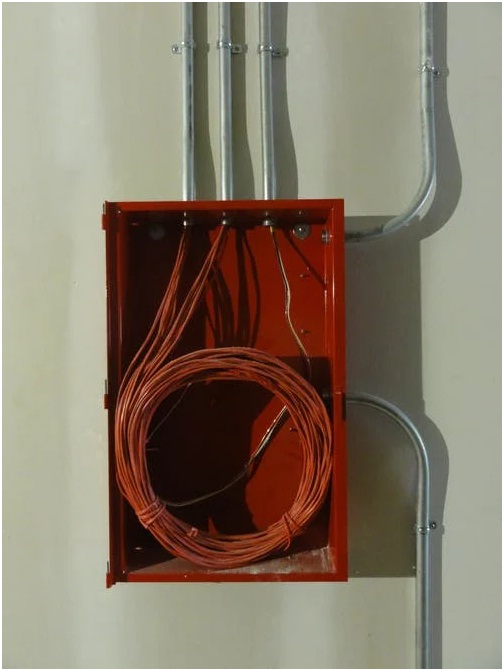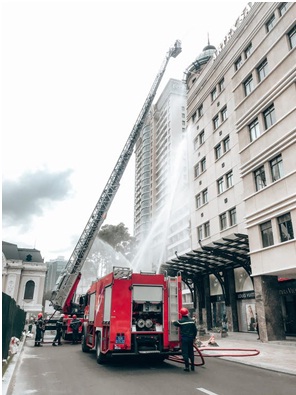Traits That Engender Quality in AWG Fire Alarm Cable
15th Jun 2021

Our name, EWCS Wire, says it all. We are the Electrical Wire & Cable Specialists, so when you need to learn something specific about electrical wire or cable, you can bet we’re a good first source. Our online collection contains many highlights of specialty cables, including but not limited to marine grade electrical cable, extra-flexible, premium welding cable, submersible pump cable, tray cables, aluminum cables, armored cable, battery cables and solar (PV) cables, and so much more. Another subsegment of specialty cables we carry are instrumentation and alarm cables, among which AWG fire alarm cable is a subcategory.
Make no mistake about it, you can’t just use any wire or cable as a fire alarm cable. Instrumentation cables in general are some of the most highly specialized electrical cables out there, and fire alarm cables are highly specialized among them.
Yet, to understand the need for the highly specialized nature of these cables, as well as what makes those traits necessary, you need to understand how and why they are used, where, and what their purpose is.
What Is AWG Fire Alarm Cable?
To understand how to look for and identify quality in fire alarm cable, let’s first take a step back and look at what cable does in general. Some of the most generalized electrical cables we sell here at EWCS Wire are building wires and cables, which are generally made up of copper conductors (or in the case of wire, a single copper conductor) and then insulated with some special thermoplastic and color-coded to make it easy for electricians to identify what these cables are intended to be used for.
Building wire is used in almost every single house, place of public accommodation, factory, warehouse and, well, building, in the country. The basic purpose of building wire is to carry a current of electricity from one source of electrical potential to another. These wires and cables supply power to every area in the building, from the electronics in the house to the appliances, the lights and everything in between.
With building wires, the general purpose is to carry power in the form of current. With instrumentation and alarm cables, the purpose is not just to carry current to power the system, but also to convey sensitive information about the network.
Special instrumentation cables are actually useful for all different types of alarm, instrumentation, monitoring and communication networks. Typically these cables are narrow gauge and supply only low currents to the systems they power and monitor. With instrumentation cable, power is important, but so is the data carried by the wires and cables themselves.
To switch gears back to the specific case of AWG fire alarm cable, the purpose of the cable is to shuttle information from the different nodes on the fire alarm system or network. A node on the network, in this instance, might be a single fire alarm. The purpose of the fire alarm is to detect smoke or heat, and then convey that information to other nodes on the network - other fire alarms or sprinklers, in order to protect the public and help control fire. Without an uncorrupted flow of information the alarm system will collapse.

When one smoke detector detects smoke, in a home, for example, the alarm itself will go off, alerting the residents of the building that there may be a fire and that they should evacuate and contact authorities. The one smoke detector, however, does not work alone. If the alarm is tripped, it will send a signal - through fire alarm cable - to the other alarms on the system, so that all members of the building can be alerted.
This is where the sensitive nature of fire alarm cable comes into play because as a system or complex grows in scope, so does the importance of the reliability of the network of fire alarm cables themselves.
Consider a large public building that has many rooms and floors that are separated from each other. As a matter of common safety acumen - and of compliance with the law - that building must have a comprehensive network of smoke detectors, fire alarms and potentially sprinklers to help the fire alarm system safeguard the public and prevent the spread of fire.
If a smoke detector in one corner of the building on the first floor detects heat or smoke, it needs to be able to relay that warning all the way to the opposite corner of the building in an instant. Similarly, that node on the system must be ready to relay that information to other areas in the building so their sprinklers can be activated to help prevent the spread of fire - if there is one.
So as you can see, the information relayed by these fire alarm systems is of the utmost importance to the public safety as to the residents or occupants of the building. In order to protect the integrity of the data carried and to ensure that the entire system is operable, fire alarm cable itself must meet a few different requirements in order to deliver on the necessary functionality.
What Makes Good AWG Fire Alarm Cable?
Therefore the question, what makes a quality fire alarm cable? There are a few different traits that make a fire alarm cable suitable for its given applications. The truth is, most fire alarm cables - and not just those that we sell here at EWCS Wire, will feature most of these.
For one thing, fire alarm cables themselves should have heat resistant insulation. We would hope that the reason for this does not necessitate a protracted explanation. While you might hope that any of the wiring within a given system would continue to function when exposed to undue heat, with fire alarm cables that is a matter of course. A fire alarm cable that cannot function when exposed to a high level of heat is not only pointless but slightly ironic. Therefore, fire alarm cables must be finished with insulation that resists higher temperatures. If there’s ever a fire, the idea is that they’ll continue to work as expected, or close to it.
Fire alarm cables should be finished with insulation that is more than heat resistant, however. Do a little research and you will also find that most fire alarm cables are also made with insulation that does not produce toxic smoke when burning. In many cases, such as in our case here at EWCS Wire, you will see these cables listed as having “low smoke” insulation. This means that when excess heat is applied to them, they produce a minimum of smoke and are designed to produce a few noxious fumes.
It might seem like common sense, but in all reality it isn’t good enough simply for fire alarm cables to continue to function through a fire. You also don’t want them to be compounding the problem by producing dangerous fumes when they are exposed to heat, which would happen, for example in the event of a fire. Fire alarm cables without the proper, protective insulation are like a boat that leaks.
Additionally, you will also find that many fire alarm cables come with rip cords to facilitate easy stripping. Fire alarm systems are complex and traverse effectively every room in a building, sometimes several times over. This requires not only a large quantity of wire but also making a lot of connections, and the rip cords that our fire alarm cables contain streamline that otherwise burdensome, time consuming process.
Other Technical Specifications
In addition to these considerations, there are a variety of other technical specifications that you need to account for when you’re looking for the highest quality fire alarm cable that money can buy.
Among some of the more salient notes you’ll need to take are relevant to shielding and the difference between riser and plenum space. However, you may also want to account for the difference between power limited and non-power limited cables, depending on the unique needs of your system.

Shielding in AWG Fire Alarm Cable
The first thing we will address is the matter of shielding in fire alarm cables, as there are fire alarm cables that are shielded as well as those that are not. Shielding is an important attribute among some instrumentation and alarm cables as it helps to protect signals and functionality from the malicious influence of electromagnetic interference, also known as EMI.
Electromagnetic interference, or EMI, is a form of electromagnetic disturbance that can interfere with the transport of electromagnetic data or signals along a wire or cable. In extreme cases, powerful EMI can actually prevent an electrical system from functioning. In the case of data transfer that occurs in alarm systems or in security system monitoring, it can cause a complete loss of the data being carried by the system. As you can imagine, this is significantly dangerous for a fire alarm system, as the time, accurate transmission of signals along the system is necessary to the public safety.
Not all fire alarm cables must be shielded, but as the complexity of the system, and the distance covered by it, increases, the likelihood of troublesome EMI also increases. If electromagnetic interference is a concern for your system, you will want to make sure that you or your electrical engineers utilize shielded cable.
The Difference between Plenum Space and Riser Space
Another consideration you will need to make is about whether you need to utilize plenum or riser rated cable in a given space. Ultimately, this has to do with where you intend to install the cable itself.
Riser space is the vertical space that spans the different floors on a building and allows HVAC systems, wiring, water and gas pipes and other conduits to communicate across the floors. Cables must span this space in order to complete a network, but it is imperative that you only use riser rated cable in riser space, or in other non-plenum space.
By a slight contrast, plenum rated space refers to the space above a drop ceiling that is usually reserved for HVAC ducts. Just like with riser space, a specific subset of conditions exist in plenum space and therefore it is important only to use plenum rated cable in plenum space.
What Do Power-Limited and Non-Power Limited Mean?
You will also see the term power-limited in our collection of fire alarm cables. Power limited means that the cables themselves can only be used in situations where the power supplied to the wire is limited. if the voltage is exceeded, it can pose a safety risk.
Non-power limited cables do not need to be used with power-limited sources since they are not power-limited. One thing that you do need to be aware of is that you should never allow non-power limited and power limited wires to come into contact with each other as this can be dangerous. Just be aware of whether your system is power limited or not and your electrical engineers can make the proper decision about what type of cable to use.
How about AWG, or American Wire Gauge?
Finally, one minor note is on the matter of AWG. AWG, or American Wire Gauge, is a logarithmic scale used to categorize wires according to their thickness. It is an inversely proportional system that has been used for well over 150 years. The larger the number, the thinner the cross-section diameter of the wire, and the smaller the number, the thicker the wire. All other things being equal, the thicker the wire (that is, the smaller the AWG rating) the more current and voltage it can carry.
Call Us to Learn More
To learn more about the unique AWG fire alarm cables that we sell, or about any of our especially designed and developed electrical wire or cables, get in touch with us at sales@ewcswire.com or at 800-262-1598. We’d be happy to answer your questions and make sure you choose the right wire or cable for the job - whether for a fire alarm system or otherwise.
